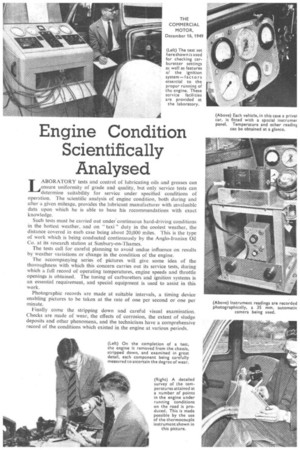Engine Condition Scientifically Analysed
Page 43

If you've noticed an error in this article please click here to report it so we can fix it.
I,ABORATORY tests and control of lubricating oils and greases can ensure uniformity of grade and quality, but only service tests can determine suitability for service under specified conditions of operation. The scientific analysis of engine condition, both during and after a given mileage, provides the lubricant manufacturer with invaluable data upon which he is able to base his recommendations with exact knowledge.
Such tests must be carried out under continuous hard-driving conditions in the hottest weather, and on " taxi " duty in the coolest weather, the distance covered in each case being about 20,000 miles. This is the type of work which is being conducted continuously by the Anglo-Iranian Oil Co. at its research station at Sunbury-on-Thames.
The tests call for careful planning to avoid undue influence on results by weather variations or change in the condition of the engine.
The accompanying series of pictures will give some idea of the thoroughness with which this concern carries out its service tests, during which a full record of operating temperatures, engine speeds and throttle openings is obtained. The tuning of carburetters and ignition systems is an essential requirement, and special equipment is used to assist in this work.
Photographic records are made at suitable intervals, a timing device enabling pictures to be taken at the rate of one per second or one per minute.
Finally come the stripping down and careful visual examination. Checks are made of wear, the effects of corrosion, the extent of sludge deposits and other phenomena, and the technicians have a comprehensive record of the conditions which existed in the engine at various periods.




























































































